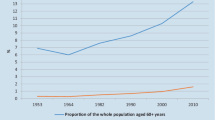Abstract
This study describes the characteristics of the Korean elderly. This study also investigates the population aging in conjunction with social and economic changes in Korea. Finally, this study explores social and economic implications with respect to the current and projected situation of the Korea elderly. Korean society has experienced very rapid changes both in demographic transition and population aging mainly due to the rapid processes of industrialization and urbanization, especially since 1960s. The rapid process of population aging has brought about the increase of dependency ratio, increasingly imbalanced sex ratio, and the decrease of the proportion of the elderly living with children. This paper concludes that the responsibility for the welfare of the elderly should shift from the family to the government.
Similar content being viewed by others
References
Choe, E.H. (1989). Population aging in the Republic of Korea. Bangkok: ESCAP, Asian Population Studies Series, No. 97.
Choe, E.H. & Lee, J.S. (1991). Social policies for the elderly: Current status and prospects. In: Population aging in Asia (pp. 62–65). Bangkok: ESCAP, Asian Population Studies Series, No. 108.
Choi, S.J. (1992). Ageing and social welfare in South Korea. In: D.R. Phillips (ed.), Ageing in East and South-East Asia (pp. 148–166) London: Edward Arnold.
Coale, A. (1964). How a population ages or grows younger. In: R. Freedman(ed.). Population: The vital revolution (pp. 47–58). New York: Garden City.
Grigsby, J.S. (1991). Paths for future population aging, The Gerontological Society of America 31: 195–203.
Hermalin, A.I. & Christenson, B.A. (1991). Comparative analysis of the changing educational composition of the elderly population in five Asian countries: A preliminary report. Ann Arbor: Population Studies Center, PSC Research Report No. 91–11.
Hur, J. (1993). The elderly and health: Physical health. In: Asian Foundation (ed.), Modern society and welfare services for the aged. Seoul.
Kim, I.K. (1987). Socioeconomic development and fertility in Korea. Seoul National University, Population and Development Studies Center.
Kim, I.K. (1995). Population aging and policy implications in Korea. Paper presented at an International Conference on Korea in Global Society, Seoul, Korea.
Kim, I.K. & Choe, E. (1992). Support exchange patterns of the elderly in Korea, Asia-Pacific Population Journal 7: 89–104.
Kim, I.Y. (1993). A comparative study of living arrangements among elderly Asian immigrants in the United States. Unpublished Doctoral Dissertation. Brown University.
Kim, T.L., Ross, J.A. & Worth, Q.C. (1972). The Korean National Family Planning Program. New York: The Population Council.
Kwon, T.H., Lee, H.Y., Chang, Y. & Yu, E. (1975). The population of Korea. Seoul: Seoul National University Press.
Lee, H.Y. (1980). Demographic transition in Korea, Bulletin of the Population and Development Studies Center 8: 5–17.
Liang, J., Yu, E.J. & Chen, X. (1986). Population aging in the People's Republic of China, Social Science and Medicine 23: 1353–1362.
Liang, J., Gu, S. & Krause, N. (1992). Social support among the aged in Wuhan, China, Asia-Pacific Population Journal 7: 33–62.
Martin, L. (1988). The aging of Asia, Journal of Gerontology: Social Sciences 43: 99–113.
Mason, O.K. (1992). Family change and support of the elderly in Asia: What do we know?, Asia-Pacific Population Journal 1: 13–32.
Min, J.S. (1985). Retirement benefits and pension system, Korean Social Security Studies 1: 61–69.
Moon, S.G. (1978). Urban-rural disparity in socioeconomic and demographic changes in Korea, 1960–1970. Bulletin of the Population and Development Studies Center, Seoul National University.
Myers, G. (1983). Mortality declines, life extension and population aging. Proceedings of selected papers of International Union for Scientific Study of Population, Manila.
Rhee, K.O., Kwon, J. & Lee, W. (1990). A study on the support for the elderly. Seoul: Korean Institute for Health and Social Affairs.
Rhee, K.O., Kwon, J. & Kang, H. (1991). A study on the establishment of home help system in Korea. Seoul: Korean Institute for Health and Social Affairs.
Rhee, K.O., Chang, M., Roh, Y. & Park, J. (1993). Development of welfare policies for the elderly. Seoul: Korean Institute for Health and Social Affairs.
Sung, K.T. (1990). A new look at filial piety: Ideals and practices of family-centered parent care in Korea, Gerontologist 30: 610–617.
Tu, E.J., Liang, J. & Li, S. (1989). Mortality decline and Chinese family structure: Implications for old age support, Journal of Gerontology: Social Sciences 44 (suppl.): s157-s168.
Author information
Authors and Affiliations
Rights and permissions
About this article
Cite this article
Kim, I.K., Liang, J., Rhee, KO. et al. Population aging in Korea: Changes since the 1960s. J Cross-Cultural Gerontol 11, 369–388 (1996). https://doi.org/10.1007/BF00115802
Issue Date:
DOI: https://doi.org/10.1007/BF00115802




